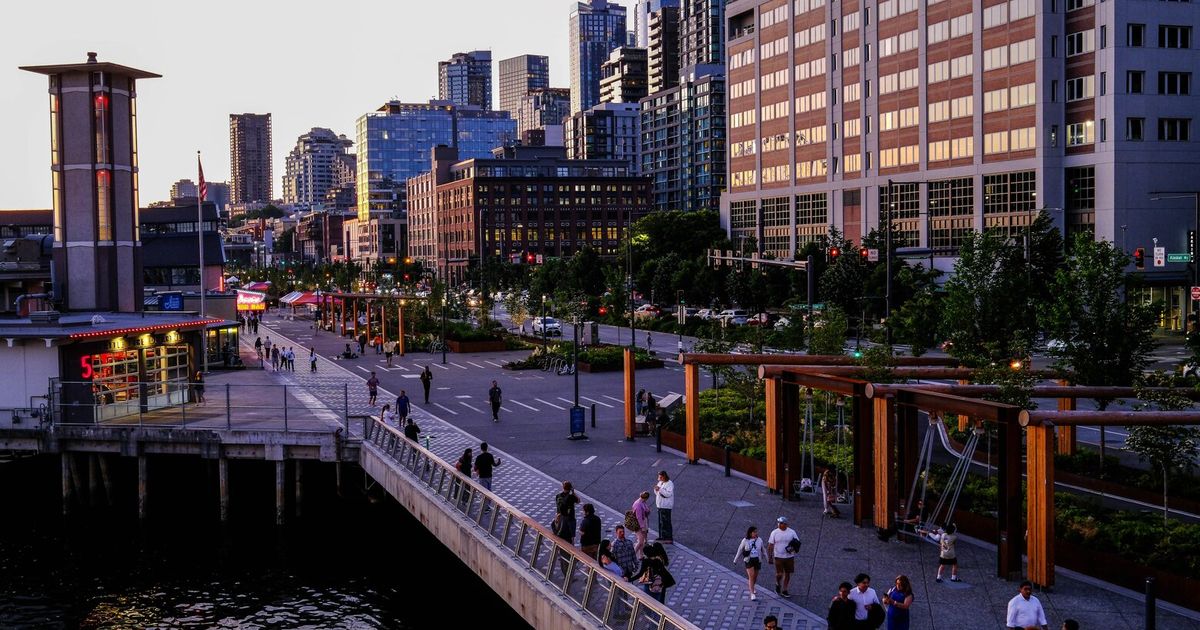Tourists aren’t the only ones buzzing over Seattle’s new waterfront.
Restaurateurs, retailers and other entrepreneurs are also scrambling for a piece of the action in a neighborhood transformed by the replacement of an antiquated elevated freeway with tree-lined boardwalks and a soaring pedestrian bridge.
Leasing inquiries have surged since the Overlook Walk debuted in October and began funneling foot traffic to the waterfront from Pike Place Market. Even on the east side of Alaskan Way, where many storefronts stood vacant for years, “Coming Soon” signs are slowly appearing.
“We put in an offer and moved forward as quickly as we could,” says Andy Gundel, co-owner of Ballard-based Urban Family Brewing, who leased a large space across from Pier 54 after visiting the waterfront late last year and seeing the crowds. “It was a no-brainer.”
Still, for all the entrepreneurial excitement, it’s not quite the land rush some expected from a multibillion-dollar makeover that turned blocks of often-aging properties into water-view real estate.
While interest in retail spaces has picked up, other property segments are comatose.
Waterfront condo sales are sluggish and prices are down. Nearly a third of waterfront office space is vacant, according to an analysis of the corridor between the water and First Avenue that runs from South King Street to Myrtle Edwards Park by real estate data firm CoStar.
“We’re at zero percent occupancy,” says developer Greg Smith about The Jack, a seven-story mixed-use office building his company, Urban Visions, finished in late 2023 at the corner of Alaskan Way and South Jackson Street.
Real estate insiders like Smith blame that sluggishness on the same factors that have hamstrung the entire downtown property market — notably, remote work, high interest rates and ongoing concerns about public safety. Just last month, a man in a wheelchair was hospitalized after being shot not far from the ferry terminal.
In time, real estate experts say, momentum from the new waterfront will spill into the broader property market.
But they don’t expect it to happen fast or to lift all property classes at the same speed. “It’s just still so early in the game,” says Elliott Krivenko, CoStar’s Seattle director of market analytics.
Retail ready
So far, optimism seems most plausible in the retail property market, which feeds on the very thing the new waterfront is already mass producing: foot traffic.
In April, May and June, the waterfront area saw 3.2 million domestic visitors, according to cellphone data provided to the Downtown Seattle Association by Placer.ai. (International visitors don’t show up in the data.)
That’s up 20% over the same period in 2024 and, importantly, it’s less than 4% below the same period in 2019, before COVID-19 emptied the city’s tourism and hospitality sectors.
Longer term, project backers expect the new waterfront to lift total waterfront visitation to as high as 15 million a year, up from 7.4 million in 2024.
Those crowds are clearly making the waterfront more attractive to businesses, especially businesses focused on food, drink and leisure spending.
“Everybody wants to be affiliated with the success of the waterfront now,” says Bob Donegan, a longtime champion of the waterfront project and president of Ivar’s, the Seattle-based seafood restaurant chain.
As important, simply the prospect of those crowds kept many waterfront retail tenants from bolting during the years of demolition and noise, says Ryan Smith, of Martin Smith Inc. The family company owns Pier 55 and Pier 56, which have ground-floor retail and many tourist-oriented tenants.
“They lived through the construction, and they’re very excited (they) now get the benefit of this new waterfront,” said Smith of tenants at the piers, which he says are 95% leased.
Vacancy data for waterfront retail properties is spotty, but a survey by the Downtown Seattle Association shows the number of vacant waterfront retail spaces has fallen by almost half since 2023.
Still, the waterfront retail property market faces challenges.
Although Waterfront Park itself has an extensive security operation, some businesses in the area say they’re still dealing with drug dealing and other problems, especially on the east side of Alaskan Way and in Pioneer Square.
Seattle police don’t break out crime statistics for the waterfront area, but in three downtown “micro” neighborhoods that include the main waterfront sections, reported crime was up 22% in the first seven months of 2025 compared with the same period in 2024, while incidents of violent crime were down 5%.
Other challenges have little to do with the waterfront itself.
With so much retail happening online, especially since the pandemic, even retailers eager for a waterfront presence often want smaller spaces, which dampens overall leasing demand.
And with roughly a third of downtown’s prepandemic workforce still missing, according to cellphone data, there’s simply less of the spending by office workers that sustains shops and restaurants when tourists aren’t there.
Out of office
If retail is the waterfront’s most promising property segment, office is its most troubled.
Office vacancy in the waterfront corridor is now at 30.5%, or just a point lower than in the downtown core, according to CoStar.
Part of the problem, some landlords say, is local issues, such as public safety or a shortage of public parking due to the loss of spaces under the old viaduct.
But most concede that the waterfront office market’s bigger problem is … the office market.
Although Amazon and some other firms have brought workers back to their offices, many continue to allow some remote work and have downsized their offices as a result.
That has generated a huge surplus of vacant office space in and around downtown, making it even harder to fill waterfront spaces.
It has also contributed to a string of office foreclosures, among them several waterfront-area buildings formerly owned by office developer Martin Selig.
Paradoxically, even the waterfront’s new success has added challenges.
With the viaduct gone, some office tenants say landlords who kept rents low during construction are raising them to reflect the now-premium views.
“The benefit of having a double-decker freeway right outside of our window was (that) our rental rates were quite competitive,” said Josh Brown, executive director of Puget Sound Regional Council, which recently moved from its longtime offices on Alaskan Way to less expensive space on Third Avenue.
Waterfront landlords and brokers, on the other hand, are betting those expensive views, along with other waterfront amenities, will eventually be prized as perks employers can use to lure remote workers back to the office.
Office space might be cheaper elsewhere downtown, says Urban Vision’s Greg Smith, “but as an employee, are you going (to want) to be along Third Avenue?”
Smith and other landlords think the new waterfront can only help the office market, by persuading locals — including, presumably, many remote workers — to reconsider a part of the city they wrote off during COVID.
That’s a plausible theory, though it may take time to pan out.
Waterfront visits by people who live within 10 miles of downtown were up 21% in April, May and June compared with the same period in 2024, but were still down nearly 6% versus 2019 levels, according to cellphone data.
Rooms with a view
All the forces at play in the waterfront real estate market are highlighted in the residential segment.
In the condo market, hesitation by buyers has swelled inventory and forced some sellers to cut prices, sometimes substantially.
That has been a disappointment for condo owners who, as part of the waterfront project’s local improvement district, faced an assessment to help fund the project.
“One of the things that was used to justify the local improvement district … was that the value of our waterfront properties was going to increase,” says Jim Wagonfeld, who lives with his wife, Judy, in the condo on Alaskan Way they bought in 1999.
A property-by-property appraisal done for the city in 2019, shortly after the improvement district was enacted, estimated that the waterfront improvements funded by the LID assessment, had they been completed in 2019, would have boosted the value of the Wagonfelds’ condo by 2.75%, or $40,769, that year.
As it happened, the assessed value of the Wagonfelds’ condo, after climbing in recent years, has fallen by more than $200,000, or 14%, since 2019, according to King County records.
Most of the other condo units in the Wagonfelds’ building have also lost value, as have many commercial properties in and around the waterfront.
Some waterfront property owners blame those declines at least partly on local issues, such as street noise; an energetic individual some refer to as “Bongo Man” often serenades the new waterfront late into the night, some condo owners say.
But brokers say the bigger culprit is higher interest rates, currently at almost 7% for a 30-year fixed-rate mortgage.
At that rate, a $700,000 1-bedroom condo with a 20% down payment means a monthly mortgage payment of around $3,500, plus an additional $1,000 or so in HOA fees and property taxes, says Olga Dyckman, a veteran broker specializing in downtown condos.
At that price, even the tech workers who once fueled a lot of downtown condo sales often decide to stay in their downtown apartments, which further depresses prices, says Dyckman.
The good news, Dyckman adds, is that if sellers can wait, even a modest drop in interest rates, to 5 ½% — “will bring buyers back.”
Light at the end of the tunnel
Many of the new waterfront’s boosters take a similar long view.
Marshall Foster, who ran the city’s office of waterfront and civic projects before becoming director of Seattle Center in 2023, concedes that the benefits of the new waterfront for property values have been overshadowed by interest rates and other market factors.
Even so, Foster says, the new waterfront is still having a positive effect on property values. And that benefit will keep accruing long after those market factors diminish and as the new waterfront becomes steadily more established as a desirable neighborhood.
He urges frustrated property owners to “focus on the long-term perspective of rebuilding.”
In the meantime, there are already glimmers of warmth in some of the cooler parts of the waterfront property market.
Developers are clearly itching to return to the waterfront’s apartment market, where a recent slowdown in construction has left such a shortage of units that rents are rising twice as fast as in the larger Seattle area, according to CoStar.
In June, developers updated permitting documents for a 17-story, 200-plus unit apartment planned since at last 2019 for one of the last big undeveloped waterfront parcels, a parking lot on Alaskan Way across from Pier 55.
And in May, Seattle-based Urban Renaissance Group assumed management of a prime Alaskan Way parcel that Martin Selig had intended for a mixed commercial-residential building; the group plans to “completely redesign and re-entitle the project,” according to the Puget Sound Business Journal.
Those kinds of waterfront property investments take years to pay off.
But some smaller real estate moves are already showing results.
After considering a waterfront location for nearly a decade, Seattle ice cream entrepreneur Molly Moon finally opened a store, her 12th, near the ferry terminal in May. Since then, she said, it has become “our most successful location.”
Gundel, with Urban Family Brewing, is betting on the same kind of result for his new waterfront location, which will be roughly twice as big as the place in Ballard.
Gundel initially considered taking just half the space to curb the already high costs of a new location.
But that left him in the classic real estate dilemma: if the new waterfront booms and retail space becomes scarce, going small would become a liability.
“The thought was, ‘If this takes off in the way we want it to, we’re going to be kicking ourselves for not just taking the leap,’” Gundel says.
This coverage is partially underwritten by Microsoft Philanthropies. The Seattle Times maintains editorial control over this and all its coverage.

